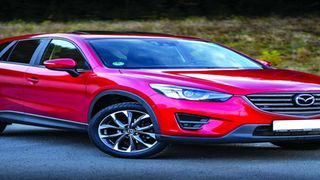
A red metallic 2020 Mazda CX-5.
| Pool | Nation Media GroupDN2
Premium
I want to ditch my 2012 Mazda CX5 2.2L turbo diesel and upgrade to a better crossover...
What you need to know:
- I would choose for you, but there are people out here just waiting to prove that I favour certain brands over others for purely subjective reasons.
- There are some conflicting characteristics in your list of preferences. You want reliability? Go Japanese, preferably Toyota
Hi Baraza,
I'm a motor enthusiast and a regular reader of your column. I currently own a 2012 Mazda CX5 2.2L turbo diesel. After reading a review you did on it a while back, and also verifying those facts with my own car, I have decided to change to another vehicle.
This is despite the fantastic power the motor gives and the sporty feel of the car. I'd like to change to a similar class cross over, but different manufacturer.
I am an employee who does a lot of intercounty travel that is rarely off-road though I still encounter the massive potholes, unmarked bumps and poor road signage.
In this aspect, reliability is key, next to that is the price range because I'd much rather do a trade in even if to add a few shillings on top than deal with online car selling conmen.
The third thing in terms of priority would be acceleration and ability to overtake safely since our roads are busy with slow trucks.
Hello,
I'd really like to help out here, but I cannot because you haven't given me a shortlist to work with. This is a problem and I will give several reasons why:
1. The crossover class of which the CX5 is a member is also the most profitable automotive segment currently and for the past few years. I believe I have mentioned this before. The result is every manufacturer worth mentioning and a few others you have never heard of makes a crossover of some sort.
Some like Toyota make so many crossovers. It's hard to tell which is which. That in turn means you are asking me to choose for you a vehicle from a list comprising hundreds of vehicle. No, I will not. I review and compare cars but not hundreds of cars at once.
2. I would choose for you, but there are people out here just waiting to prove that I favour certain brands over others for purely subjective reasons. This is a tiresome lot to deal with and I'd rather not give them any more fuel for their misguided fire, which is why I would rather choose a vehicle from an existing shortlist created by you than have to pick one from the aforementioned list comprising hundreds of vehicles.
3. There are some conflicting characteristics in your list of preferences. You want reliability? Go Japanese, preferably Toyota (come on, we all know that). Price range will be an issue though, Toyotas are generally not cheap because of market dynamics, but their prices, though steeper than their Japanese rivals, are worth the price of admission.
Acceleration means you go European, where they too have hundreds of high performing crossovers spread across the western fringe of the continent and on that rainy rock in the North Atlantic that is historically known for its imperialist tendencies (the UK, in case you hadn't figured out what I was referring to).
However, there is a high performance Japanese crossover whose reliability is middling, price is competitive (somewhat) and goes like a rocket ship, but it comes with one caveat: it is from the same manufacturer you are trying to dodge. I'm talking about the Mazda CX7.
It is overage, having ceased production in 2012 in favour of the CX5 you want to ditch, but the one with the 2.3 liter turbo was a ground-hugging passenger aircraft if there ever was one. Of course you paid for your speeding sins at the petrol station, but by god, that car was fast!
What can you tell me about the Turbo Charge Forester 2012 model?
Hello Chief,
I hope this email finds you well. Thanks for the good work you are doing, this goes a long way for naive minds such as myself on matters cars.
This is more of a follow up on your insights on the Subaru. I have been saving up for a “something called the Crosstrek” as you put it some time back, however after some soul-searching, I decided to man up and go for the turbo charge forester (2012 model). I however would like to get some clarifications from you before going down this road. (Ps please excuse my naivety and knack for numbers)
1. The Subaru TSB covers literally all models from 2012 through to 2017. Does this mean that by purchasing the Forester (or any other model for that matter) that was manufactured herein, I will literally be booking myself in for a complete CVT breakdown and what have you?
2. Why did you recommend steering clear of anything labeled STi?
3. How exactly do you prevent (read delay) head gasket damages on your Subaru?
4. You did recommend to “avoid short unnecessary trips” on the forester. What exactly are we looking at here, a kilometer, maybe two? (I know, I know, this is something every driver out there should know)
5. On the timing belt issue, would you recommend changing it immediately after purchase? (I’ve honestly come to terms that the mileage will most likely be tampered with and as such I would get to that 100,000km limit without even knowing it.)
6. You did talk of having changed El-turbo’s engine at some point in time. Critics say that for the Subaru this is kind of a norm? Please share your thoughts on this.
7. Do I need to run the Forester at relatively high speeds from time to time to keep it alive? If so, what speeds are we looking at and for how long?
8. Is there any other specific issue to look out for when purchasing and driving this specific car? It’s locally sourced of course.
Best Regards,
Evans.

Subaru Forester.
Hello Evans,
1. If Subaru issues a TSB against their CVT transmissions, then that means that they tried to address the problem. Now this is what usually happens when a TSB is issued: the dealerships maintaining vehicles (usually under warranty) are instructed to perform repairs or fixes quietly and (again usually) at no cost to the customer. The dealers then log which cars have been fixed under the TSB.
That means it’s up to the buyer of the car to ensure the fix has been carried out. These logs are submitted to the manufacturer so that they can keep track of which cars have been fixed and which ones have not. The list is then made available for searching by prospective buyers of used cars such as yourself.
Therefore, you may not necessarily be booking yourself in for a heartbreak by buying a vehicle affected by the TSB, use the VIN or chassis number to search online and find out if the particular vehicle you are eyeing was fixed under the TSB.
2. Did I say steer clear of a STI? That’s odd... but if I did it must have been something to do with fuel economy or the potential inability to fully harness its tremendous firepower, making untalented drivers a rolling hazard.
3. Ensure your oil levels are always correct and keep checking your coolant as well. Use the correct grade of fuel and try to keep engine speeds below 5000rpm. However, previous ownership still remains an unknown variable in this equation, so you may still blow a gasket or two despite your best intentions.
4. Yes, a kilometer or two is classified as a “short unnecessary trip”. Try and make your drives at least 10 kilometers long or more.
5. You don’t have to change the timing belt immediately after purchase. A physical check will let you know whether or not it’s due for replacement. If it looks wonky, then change it immediately.
6. It’s not really the norm to swap out Subaru engines, but I will admit it is a fairly common occurrence with the turbocharged/high performance variants. This is especially true once you start fiddling with the engine in the name of “modding” (applying modifications).
7. You don’t need high speeds, nobody does, but once in a while you do need high revs in what we call an Italian tune-up. An Italian tune-up is removing carbon from the engine by revving the beans out of it. It may sound contradictory to point 3 above but hey, it is what it is. You could aim for the red line and hold the revs there for a few seconds at a time, several times. This is of great importance if you are running a direct injection fuel system which is more prone to carbon buildup.
8. Apart from gaskets and turbos, check the suspension. Local drivers tend to have little respect for road surfaces, so it’s easy to buy a car with busted shocks and/or worn out bushes.
You own two of them, it should be you reviewing the Nissan Murano…
Hi Baraza,
Could you kindly review the Nissan Murano. I have owned two of them so far.
Kind regards,
Alex.
Hi Alex,
Having owned two Muranos, don’t you think it should be you reviewing the vehicle for us? Ownership of a pair of the same model of car is a lot more exposure than I typically get for cars I review, which vary from a few hours to probably a week, tops.
Your ownership experience would also be more relevant, since my own exposure can only allow me to delve into first impressions - not good for the Murano, I don’t like the generous chrome lashings on the nose and the bulbous silhouette, more so towards the rump-like rear, things like pricing, driving characteristics, practicality and specification levels.

Nissan Murano.
You on the other hand can explain in great detail what the car is like to live with every day, its maintenance and running costs, its relevance to daily driving and how long it took until you stopped looking at it after parking it, which is a surefire sign that the infatuation has worn off and you are beginning to have second thoughts subconsciously.
Care to revert?
Which of these four cars should I get my lady?
I’m looking to get my lady a car she can use for errands and occasional out of town business. Was thinking of Demio, Note, Vitz or Fit. Which one would you advise me to get?
Thanks
Regards
Steve
Go for the Vitz. The Demio is actually the best of the lot but they’re too many around and I still hear whispers about “availability of spares”, so you may as well give it a pass on that account. It is also attaining cliché status: many Demios are driven by many women, do you want your lady to be yet another faceless female flinging a fancy fun-sized ferry?
The Note is a Nissan from the mid-2010s and you know what that means. I don’t have to say it (or write it).
The Fit, though coming from a company second only to Toyota in reliability terms, has lately featured in this column one or two times too many for my liking, and for all the wrong reasons. Something may be amiss somewhere.
The Vitz is a Toyota, with all the attendant advantages that badge bears, mostly centered around dependability and ease of maintenance. Despite my exhortations for punters to ignore this particular metric, I will include it anyway: resale value is also at a peak for this car.
Go for the Vitz.
Baraza, keep up the good work
Hi Mr Baraza,
Hope you are well and doing okay. I am writing to you to thank you for the advice and detailed information you gave on your column on August 5,2020 on SUVs. Your comparison of the Mitsubishi Pajero i.o. to the Suzuki was well researched. Again, I say thank you.
Dr Kamuti Kariuki
You are most welcome daktari. Keep reading.





